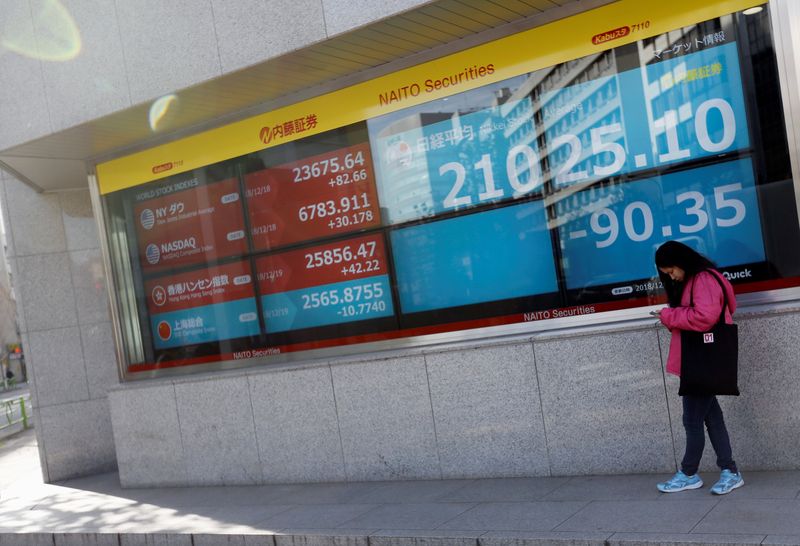 © Reuters. FILE PHOTO: A woman stands in front of a screen displaying Japan's Nikkei share average, U.S. and other countries' stock market indicators outside a brokerage in Tokyo, Japan December 19, 2018. REUTERS/Issei Kato
2/2
© Reuters. FILE PHOTO: A woman stands in front of a screen displaying Japan's Nikkei share average, U.S. and other countries' stock market indicators outside a brokerage in Tokyo, Japan December 19, 2018. REUTERS/Issei Kato
2/2
By Lawrence Delevingne
(Reuters) -Shares on Wall Street took a breather on Friday after a tech-driven rally and U.S. Treasury yields rose to fresh heights as markets evaluated a world of elevated interest rates and the effects of Russia's war in Ukraine.
The Nasdaq fell about 0.16% as technology and healthcare stocks pulled back, while the Dow Jones Industrial Average and S&P 500 edged up about 0.5%, with energy and financial shares rising on oil price gains and bets on interest rate hikes by the Federal Reserve.
MSCI's gauge of stocks across the globe was up 0.11%, adding a second consecutive week of gains for the first time in 2022. The pan-European STOXX 600 index also inched up 0.11%, but was down on the week.
Share prices have been supported by global flash Purchasing Managers' Index (PMI) data for March this week showing the world economy was broadly resilient, but the longer-term economic outlook is making investors cautious. Barclays (LON:BARC), for example, cut its 2022 world economic growth forecast this week to 3.3% while traders have ramped up short bets.
Global bond markets continued to see a weeks-long sell-off.
Yields on benchmark 2- and 10-year U.S. Treasury notes jumped to almost three-year highs on Friday as the market anticipates inflation will spiral higher, forcing the Fed to aggressively hike interest rates.
Ten-year Treasury yields rose 14.3 basis points to 2.484%, a rate last seen in early May 2019. The 2-year yield, which typically moves in step with interest rate expectations, was up 16.2 basis points at 2.287% - a rate also last seen in early May 2019.
Chicago Fed President Charles Evans was the latest U.S. policymaker to sound more hawkish, saying on Thursday the Fed needs to raise interest rates "in a timely fashion" this year and in 2023 to curb high inflation before it is embedded in U.S. psychology and becomes even harder to get rid of.
Bank of America (NYSE:BAC) (BofA) joined a small but growing number of top investment banks calling for more aggressive interest rate increases from the Fed against a backdrop of soaring inflation data. The bank now expects two hikes of 50 basis points (bps) each at its June and July meetings with "risks" of those expectations being pulled forward into May and June respectively.
Markets expect U.S. interest rates to rise by as much as 190 bps in total over the rest of this year, after a 25-bps hike last week. Investors are assigning an approximately 77% probability of a 50-bps rate hike in March.
Morgan Stanley (NYSE:MS) market analysts wrote in a note late Thursday that fast Fed action was not overly concerning for the economy.
"While a disorderly tightening of financial conditions remains a risk to the outlook, particularly in areas like credit, our baseline growth outlook remains constructive," they wrote. "We think (it) helps contain risks that financial conditions become too dislocated in response to the Fed's actions."
OIL REVERSAL
Oil prices turned positive on Friday after reports of a missile strike and a fire at Saudi Arabia's state-run oil company Aramco (SE:2222)'s facility.
U.S. crude rose 0.63% to $113.05 per barrel and Brent was at $119.78, also up 0.63% after dropping more than $3 earlier in the session. Both benchmarks were heading for their first weekly gains in three weeks. [O/R]
The U.S. dollar edged higher against a basket of major currencies on Friday, a third straight day of gains. The euro was slightly lower.
"The one thing everyone can agree upon is inflation is going to be longer-lasting and a lot of that will be sticky and that will complicate what central banks do," said Edward Moya, senior market analyst at Oanda in New York. "You will probably see the dollar lead the charge with rate hikes, Europe will lag and that interest rate differential should provide some support for the dollar."
Demand for safe-haven assets including gold and the Swiss franc remained resilient as the conflict in Ukraine continued. Moscow on Friday signaled scaling back its ambitions in Ukraine to focus on territory claimed by Russian-backed separatists as Ukrainian forces went on the offensive, recapturing land on the outskirts of the capital Kyiv.
Spot gold remained elevated at $1,955 an ounce, down about 0.10% for the day. [GOLD/]

